If your customers are leaving great reviews about your business and you don’t include such testimonials in your marketing…
…you’re leaving a lot of money on the table.
Testimonial advertising could be just the strategy you need to generate more sales for your business — and today, we’ll show you how.
In this article, we’ll discuss what testimonial advertising is, examples of successful testimonial ad techniques, and how this strategy can lead to more sales for your business.
What is Testimonial Advertising Definition?
Testimonial advertising showcases endorsements or reviews from satisfied customers to promote a product or service.
Testimonials typically involve written, visual, or audio statements from customers sharing their positive experiences with a brand, products, or services, often recommending the business to others.
Testimonial advertising involves promoting authentic customer statements across various marketing channels (e.g., sales or landing pages, social media platforms, search engine ads, affiliate promotions, etc.).
Testimonial ads aim to use genuine customer reviews to build trust with your potential customers.
Testimonial Ads vs. Testimonial Commercials
Testimonial commercials, also known as testimonial ads, utilize statements or endorsements from satisfied customers to advertise or promote a specific product or service.
However, there is a technical difference between the two. Ads are delivered through various media (social media, tv, radio, text, billboards, flyers, etc.), while commercials usually refer to just video or radio format promotions.
Testimonial ads can be:
- Reposted customer testimonials received via email or social media or from review platforms such as Amazon or Yelp;
- Customer success stories or case studies;
- Consumer-generated content (e.g., testimonials made on a customer’s personal website or social media accounts);
- Strategically positioned testimonials on your conversion-focused sales and lead generation pages;
- Video or radio ads incorporating clips of customers’ self-recorded testimonials;
- …the list goes on.
Testimonial ads can be any length — from 1 to 2 paragraphs of plain text to a highly-produced 10-minute video. The main quality to prioritize is ensuring your testimonials come across as sincere, positive endorsements of your business from customers.
Can Testimonials Be Prompted?
Yes, they can.
In fact, when you request testimonials from your customers, it’s good practice to provide question prompts to ensure customers comment about the most marketable aspects of your products, services, or business.
That said, don’t misinterpret prompting your customers with thoughtful questions to mean giving them a pre-written script. Scripted or forced responses are never genuine testimonials and will be inauthentic for your brand.
Viewers often sense when testimonials aren’t given in the speaker’s own words and will lose trust in your brand as a result.
Testimonial Ads vs. Endorsements
The difference between a testimonial ad and an endorsement depends on who is delivering the message. Endorsement ad campaigns are associated with public figures and industry authorities — high-visibility individuals with large followings.
| Testimonials | Endorsements |
| Statements by satisfied customers about their experience | Public approval or recommendation by a celebrity, influencer, or industry expert |
| Typically obtained through a direct request from customers | Often sought after through paid partnerships or sponsorships |
| Focuses on individual experiences | Relies on the reputation and credibility of the endorser |
| Often includes personal details and stories | Typically shorter and more concise |
| Can be used in marketing materials with permission from the customer | Usually requires a legal agreement and compensation |
| More suitable for small businesses and local brands | More common among larger companies and well-known brands |
| Viewed as more genuine and authentic | Can sometimes be seen as less trustworthy or biased |
Should You Do Testimonial Advertising?
YES.
Testimonial advertising can be a powerful strategy for your business in several ways.
First, testimonial ads can help you build trust and credibility with potential customers. According to BigCommerce, 72% of consumers say positive testimonials and reviews increase their trust in a business.
When your target audience sees people who look or sound like them sharing positive experiences with your product or service, they are more likely to trust your business and feel safe to buy.
Second, testimonial ads are a powerful way to showcase the benefits of your product or services. Customers often have different needs and priorities, and a clear, articulate testimonial can help you highlight the features and benefits of your business that are most relevant to the range of customers you serve.
Third, testimonial ads are a cost-effective promotion strategy. Testimonials can be collected easily and shared quickly (especially through social media or on your website), making them an affordable way for your business to reach potential new customers.
Types of Testimonial Advertising
There are several types of testimonial advertising, each of which can be used in different ways to promote your business or its products and services. The most common types of testimonial advertising include:
- Written testimonials. These are written accounts from customers describing their experiences with a product or service. They can be published on your business’s website, in marketing materials, or on social media.
- Video testimonials. These are videos where customers describe their experiences with a product or service. They can be recorded and shared on your business’s website, YouTube channel, or other social media channels (Facebook, Instagram, Twitter, etc.).
- Influencer testimonials. These are endorsements from nano, micro, or mid-tier influencers who haven’t achieved “celebrity status” but have a dedicated community of followers who trust their product recommendations.
- Expert endorsements. These are endorsements from experts or industry leaders who have used a product or service and are willing to recommend it to others and provide their expert opinion publicly. These experts aren’t celebrities or high-profile individuals, but their recommendations carry weight due to the reputation they’ve built in their industry.
The type of testimonial advertising you decide to use will depend on your budget and your target audience. Different types of testimonial ads can be effective for different purposes, and it’s important to consider which type will be most effective for reaching and persuading your target customers to take action.
Testimonial Advertising Examples
Let’s now take a look at the different platforms and techniques you can use to promote testimonial ads that attract new leads and customers by analyzing some real-world examples…
LinkedIn Testimonial Ad Example by Kinsta
LinkedIn is a professional networking platform, which means it has a highly targeted audience of skilled professionals, managers, and business owners. For businesses like Kinsta, it’s an ideal place to use testimonials to promote their services.
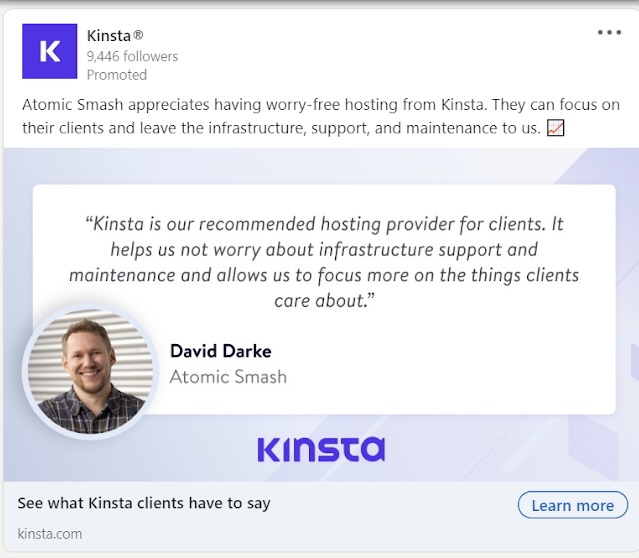
In this campaign, Kinsta features glowing customer testimonials in their ads, showcasing the big impact their services have had on their clients’ businesses.
The example post above includes a direct quote from one of Kinsta’s clients, including the client’s full name and picture, which makes the testimonial ad feel more trustworthy.
The ad also links to add customer testimonials on Kinsta’s website, showing potential new clients Kinsta is a website hosting provider people can trust.
Key Takeaways
- Include direct quotes from your customers (instead of summarizing their words) to make your testimonial ads authentic and credible;
- Link back to a testimonial page on your website, so potential customers can learn more about how your business has helped other customers (hopefully many of them!);
- Add branding to your testimonial ads so potential customers can easily identify your business.
Instagram Story Testimonial Ad Example by Semrush
Testimonial ads don’t have to be as detailed or in-depth as a case study.
In fact, a testimonial ad can be as simple as reposting a customer’s review on your Instagram Stories. Check out how Semrush has done this below:
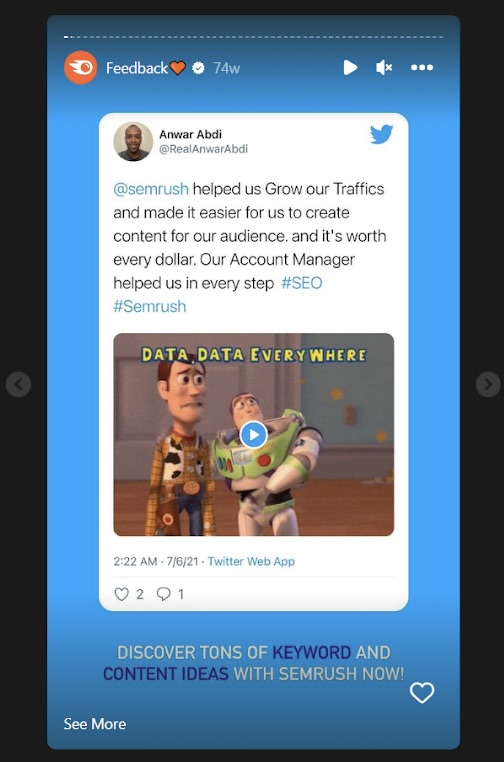
As you can see, the customer shared their testimonial on Twitter, and Semrush screen-grabbed it, shared it on their Instagram Story, and then added a call to action at the bottom of the ad. Quick, simple, and effective.
You’ve probably noticed this Semrush Instagram Story was shared over a year ago. So how did I find it?
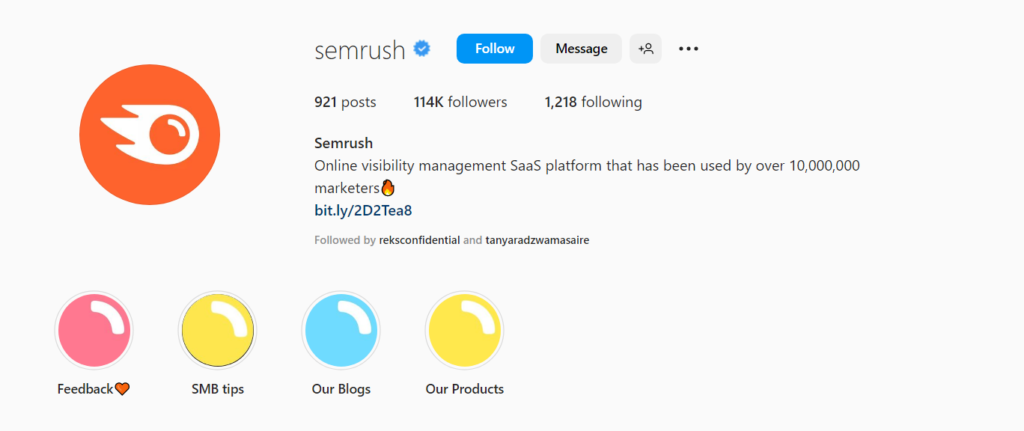
Semrush created an archive of reposted customer testimonials and turned it into an Instagram Story Highlight. So, if a prospect lands on Semrush’s Instagram page, they can tap the “Feedback” highlight and go through 30+ customer testimonials the company shared over the last year.
Key Takeaways
- Testimonial ads can be as simple as reposting a customer testimonial on Instagram (and/or Facebook) Stories;
- Add a call-to-action to your testimonial ads to guide interested prospects on what to do after they’ve viewed your ad;
- Add longevity to your testimonial ads by creating an easily accessible archive (e.g., an Instagram story highlight).
Facebook Video Testimonial Ad Example By Thrive Themes
Customer testimonials also make for great paid ads – especially videos.
Video testimonials are more attractive and are much easier for potential customers to consume than other types of ads.
This makes them more effective at capturing your audience’s attention and persuading people to take action. Take a look at this example from Thrive Themes:
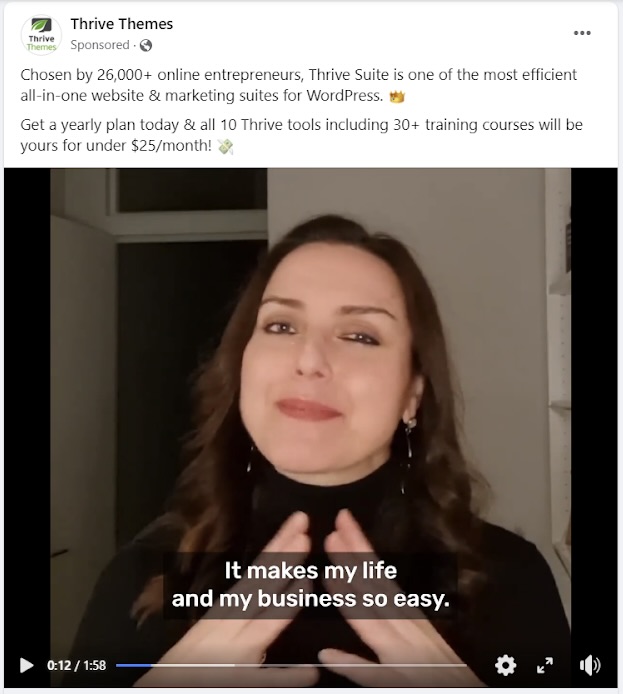
In this video testimonial ad, a customer shares her experience using Thrive Suite, Thrive Themes’ business-building toolkit of conversion-focused themes and plugins for WordPress.
Moreover, Thrive Themes includes social proof in the ad’s Primary Text area by stating how many customers use Thrive Suite – “Chosen by 26,000+ entrepreneurs”.
This video ad works because it lets an actual customer do the talking, sharing her own personal experience using the different Thrive Suite tools and how they positively impacted her business. Potential customers are more likely to resonate with this ad because it feels authentic and relatable.
These types of ads are also cost-effective because a simple smartphone video recording by your customer is all that’s needed. Add some closed captions to the video edit, and voila… instant Facebook testimonial ad!
If your customers are unsure of what to say, provide them with a few question prompts to get started.
Key Takeaways
- Customer-recorded video testimonial ads often perform well because they appear more authentic and relatable to viewers;
- Customer-recorded video testimonials are cost-effective due to the minimal production time and effort needed to publish them;
- Add social proof to your video testimonial’s Primary Text to grab attention and boost your brand’s trust factor.
Facebook Post Testimonial Ad Example by Noom
This is another example showcasing how easy testimonial ads are to create and share.
If you don’t have time or resources to create video testimonial ads, you can repost customer testimonials as static image posts on your business’s Facebook page. Take a look at this example from Noom:
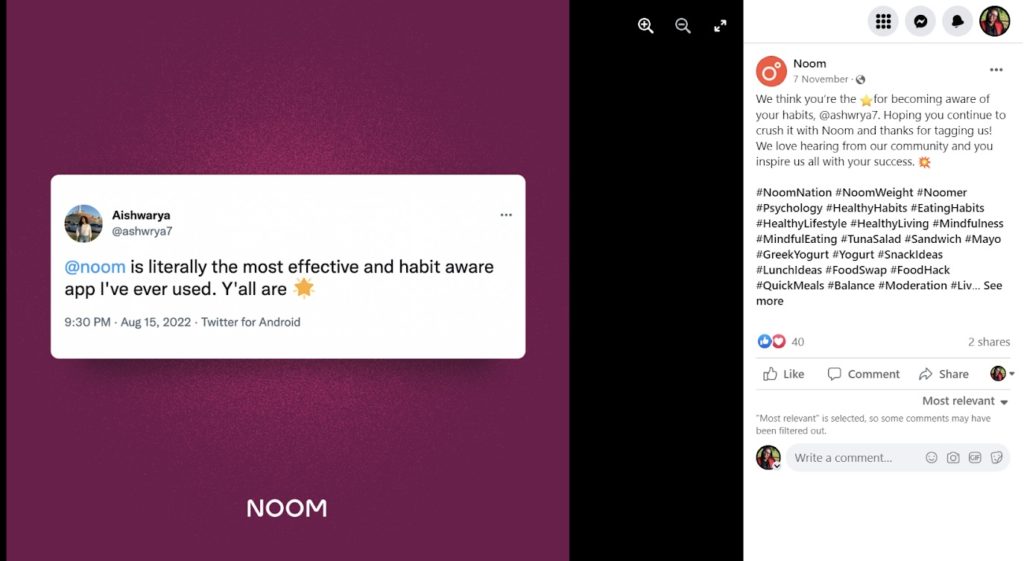
Noom screen-grabbed a glowing Twitter post from one of their customers, set it against a colorful backdrop to make it attractive, and reposted it on their company’s Facebook page.
By tagging the user in the post’s description, they’ve made the testimonial trustworthy. If a potential customer wants to confirm that this testimonial is real, they can simply look up the user’s handle to confirm.
Key Takeaways
- Take screenshots of customer social media posts and apply simple design touch-ups before publishing your ads, like adding a colorful background;
- Share the source of a customer testimonial (e.g., social media handle, full name, link to their business, etc.) to add credibility to your testimonial ads;
- Use relevant hashtags in the description of your testimonial ads to boost your post’s visibility and get it in front of more potential customers.
Influencer Testimonial Ad Example by Rachael Fuss (SkincareStandard)
Influencer testimonial ads are a great way to get your brand in front of more eyes.
Influencers are seen as trusted sources of information and recommendations, and their endorsements carry more weight with their direct followers. Influencer testimonial ads help differentiate your business from competitors and make it more appealing to potential customers.
By partnering with an influencer, you can create a sense of credibility and trustworthiness for your business since their followers trust and respect them.
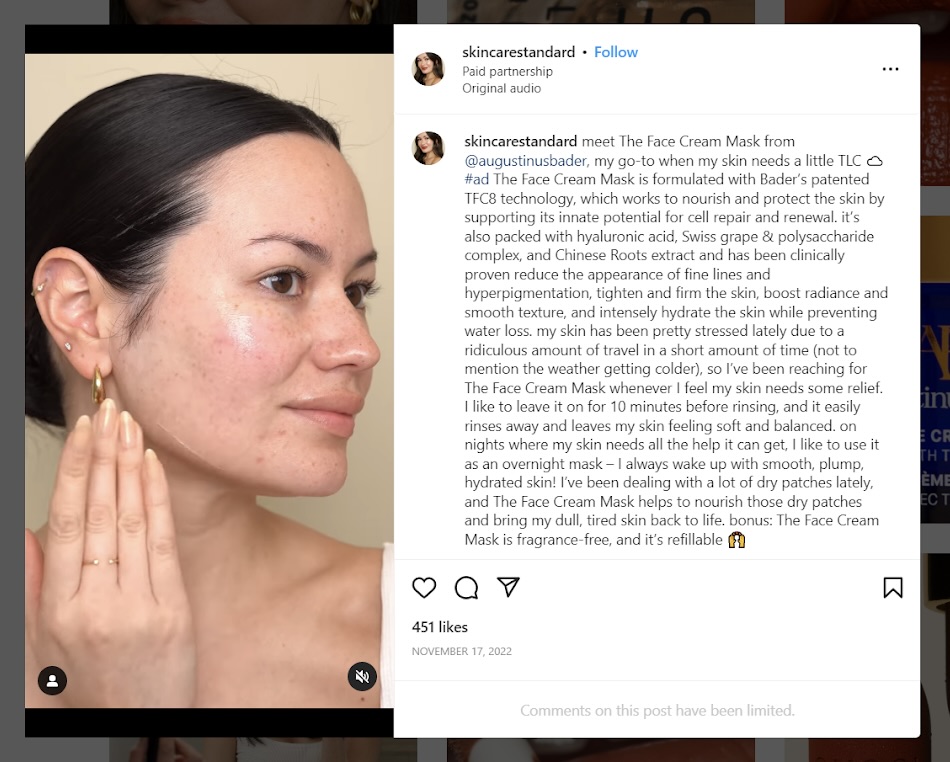
Rachael is an influencer in the skincare industry and uses her platform to offer reviews on various products. In this post, she speaks about her experience with Augustinus Bader’s Face Cream Mask and provides a glowing review on how it helped her skin.
This testimonial ad works because Augustinus Bader partnered with an influencer relevant to their industry (Rachael Fuss), giving their brand greater access to potential customers they may not have been able to reach otherwise.
Key Takeaways
- Be upfront about disclosing partnerships or sponsored content, and make sure your influencer partners disclose sponsored content in accordance with relevant laws and regulations. This will help maintain the trust you’ve built with your audience while ensuring your influencer marketing efforts are both ethical and effective;
- Influencer testimonial ads work best with influencer partners who have a genuine following and are relevant to your brand and industry. Consider an influencer’s engagement rate, content quality, and overall fit with your brand before partnering with them;
- Take time to get to know the influencers you want to partner with and offer them value beyond monetary compensation. This can help to establish more authentic, effective, and lasting partnerships.
YouTube Testimonial Ad Example by Zapier
Customer interview testimonial ads offer a form of social proof that increases trust and credibility for your brand. They allow potential customers to see how current customers use and enjoy your products or services, which can often be more effective than traditional advertising.
Take a look at this testimonial ad from Zapier:
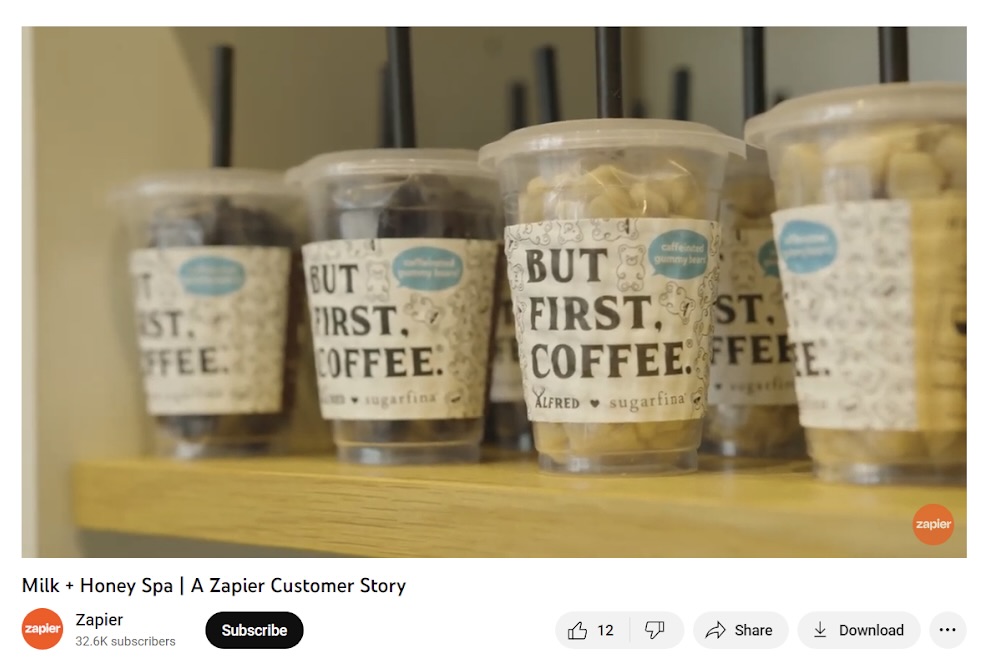
Zapier takes their video testimonials to the next level by filming their customer testimonials in a pro studio or, if possible, inside a customer’s actual business.
The above testimonial takes place at the Milk + Honey Spa, where the owner explains their experience with Zapier and the positive impact it had on the spa’s business performance.
However, keep in mind that testimonial ads like this require much more time and money to produce than simpler video testimonial ads. So, if you’re still an up-and-coming business with a limited marketing budget, this strategy isn’t for you.
Key Takeaways
- High-production value interview testimonials like this require planning. Have a clear idea of what you want to accomplish with your ad and what message you want to convey. Consider the specific aspects of your products or services you want to highlight when preparing your customer interview questions;
- Invest in good cameras, microphones, and lighting equipment to ensure your ad looks and sounds professional. This will create a more polished and effective video ad;
- If you can’t film the interview at your customer’s business, look for a location that is well-lit, quiet, and visually appealing. Consider the background and whether it will be distracting or add to the overall aesthetic of the video.
Testimonial Advertising: Final Takeaways
Including testimonial advertising in your marketing is a surefire way to capture your target audience’s attention and turn more visitors, viewers, and readers into prospective customers.
The best thing about testimonial advertising is that it can be done with minimal resources and still lead to big sales boosts.
Here are a few final takeaways from successfully implementing an effective testimonial ad strategy:
- Authenticity is key: Testimonial ads should include genuine, personal experiences from real customers who have actually used and benefited from your products or services.
- Simplicity works: A testimonial ad can be as simple as screenshots of a glowing customer social media post or a positive review on a platform like Yelp or Amazon. You don’t need a massive marketing budget to create effective testimonial ads.
- Credibility is critical: Including personal details like customer names, images, or social media handles communicates that these testimonials are from real customers. Just make sure you get permission to use their details in your ad before publishing.
- Collect testimonials from various customers: It’s important to use a diverse range of testimonials to appeal to a broad audience. This can include testimonials from different age groups, genders, and professions. With the right testimonial management system, you can easily capture customer testimonials on autopilot.
- Disclose your relationships: If you sponsor endorsements from influencers or celebrities, it’s important to disclose these business relationships to potential customers. This helps ensure ALL your testimonials are perceived as genuine instead of being influenced by a financial incentive.
We’ll say it again… testimonial advertising is a powerful marketing strategy that can help generate strong sales for your business and boost your brand’s reputation without having to break the bank. But the key to making any marketing strategy work is testing.
So, put your lab coat on and get creative, experimenting with the different types of testimonial ads explained above. More than likely, your customers have already posted positive comments and videos about your business on social media, but don’t be afraid to reach out to customers directly to see if they’ll craft a heartfelt, true fan testimonial just for you!
Adding great testimonial ads to your marketing might be just what your would-be customers need to take action and buy.
Also read:
- Online Advertising: Your Go-To Guide Guide to Ads
- Email Advertising for Everyone: A Laid-Back Guide
- 17 Marketing Campaigns Examples
Author Bio
Chipo Biti is the Content Marketing Nerd at Thrive Themes – the most advanced yet simple-to-use WordPress suite of website tools designed to help you build and grow a thriving online business.

